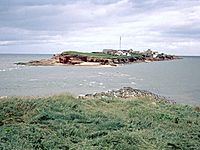Hilbre Islands facts for kids
Quick facts for kids Hilbre Islands |
|
|---|---|

Hilbre Island from Middle Eye
|
|
| Type | Common |
| Location | West Kirby, Merseyside |
| Operated by | Metropolitan Borough of Wirral |
| Open | All year, dependent on tide |
| Status | Open |
The Hilbre Islands (pronounced HIL-bree) are a group of three islands located where the River Dee meets the sea. This river forms part of the border between England and Wales.
These islands are part of the Metropolitan Borough of Wirral and are a special place called a Local Nature Reserve. They are also part of a larger area known as a Site of Special Scientific Interest, which means they are very important for nature. As of 2012, no one lives on the islands permanently. During the summer, many visitors walk to the islands from West Kirby when the tide is low.
Contents
What's in a Name?
The name Hilbre Island comes from a medieval chapel built there. This chapel was dedicated to St. Hildeburgh, an Anglo-Saxon holy woman. Because of her, the island became known as Hildeburgheye, meaning "Hildeburgh's island."
People say St. Hildeburgh lived on Hilbre Island in the 7th century as an anchorite, which is someone who lives alone for religious reasons. Some people wonder if she was a real person, while others think she might be the same as Saint Ermenhilde or St Edburga of Mercia. A church built nearby on the mainland in the 19th century, St Hildeburgh's Church, Hoylake, is named after her.
A Look Back in Time
People have lived on or visited the Hilbre Islands for a very long time, possibly since the Stone Age. In 1926, items from the Stone Age, Bronze Age, and even Roman pottery were found there.
It's thought that Hilbre Island was a place for hermits or a popular spot for pilgrimage (a religious journey) even before the Norman invasion of England. Around 1080, a small church and living area for Benedictine monks were built on Hilbre Island. This became a smaller part of the main monastery at Chester Cathedral. The islands are believed to be mentioned in the Domesday Book, a famous survey from 1086, which talks about two churches in West Kirby, one of them on an island in the sea.
The islands were given to an abbey in Normandy, which then passed them to the Abbey of St. Werburgh in Chester. Hilbre Islands became a very popular place for pilgrimages in the 13th and 14th centuries.
When monasteries were closed down in the 1500s, two monks were allowed to stay on the islands. Their job was to keep a special light, called a beacon, burning to guide ships in the river mouth. The last monk left around 1550. By then, the islands had become a busy place for trade, so much so that a special building called a custom house was set up to collect taxes on goods.
In 1692, a small factory was built on the islands to refine rock salt. There was also a pub or inn, which was open when a writer named Richard Ayton visited in 1813. However, as the River Dee started to get filled with sand and mud, trade moved to other ports on the River Mersey. This caused the trade on Hilbre Islands to disappear, and the pub closed down. Part of that old building is still used in the home of the island's caretaker today.
The islands were bought in 1856 by the people who managed the Liverpool Docks. Later, they were sold to Hoylake Council in 1945 for £2,500. In 1974, they became part of the Wirral Borough Council. The Hilbre Island Lighthouse was built on the main island in 1927.
Island Features
Hilbre Island is the biggest of the three islands. It's about 11.5 acres (4.6 hectares) in size and is about 1 mile (1.6 km) from Red Rocks, the closest part of the mainland.
The other two islands are Middle Eye (sometimes called Middle Island or Little Hilbre on maps) and Little Eye, which is the smallest. Middle Eye is about 3 acres (1.2 hectares). All three islands are made of red Bunter sandstone. The main Hilbre Island and Middle Eye are about 250 yards (228 meters) apart, and Middle Eye is about 1250 yards (1143 meters) from Little Eye.
Visiting the Islands
Hilbre Island is one of 43 islands around Great Britain that you can walk to from the mainland when the tide is low. Walking to the islands from West Kirby is a very popular activity, especially in the summer.
Little Eye and Middle Eye have no buildings or people living on them. However, Hilbre Island has a few houses, and some of them are privately owned.
What's on the Islands?
The building furthest south on Hilbre Island is the Hilbre Bird Observatory. Here, experts watch and study birds all the time. They are part of a bigger network of observatories that help track birds across the country.
In 2011, it was announced that there would no longer be a full-time ranger living on the islands. Wirral Council explained that it was hard to find someone willing to live there without electricity or running water. On the main island, there are two special composting toilets and a shelter where you can get out of the rain.
Gallery








